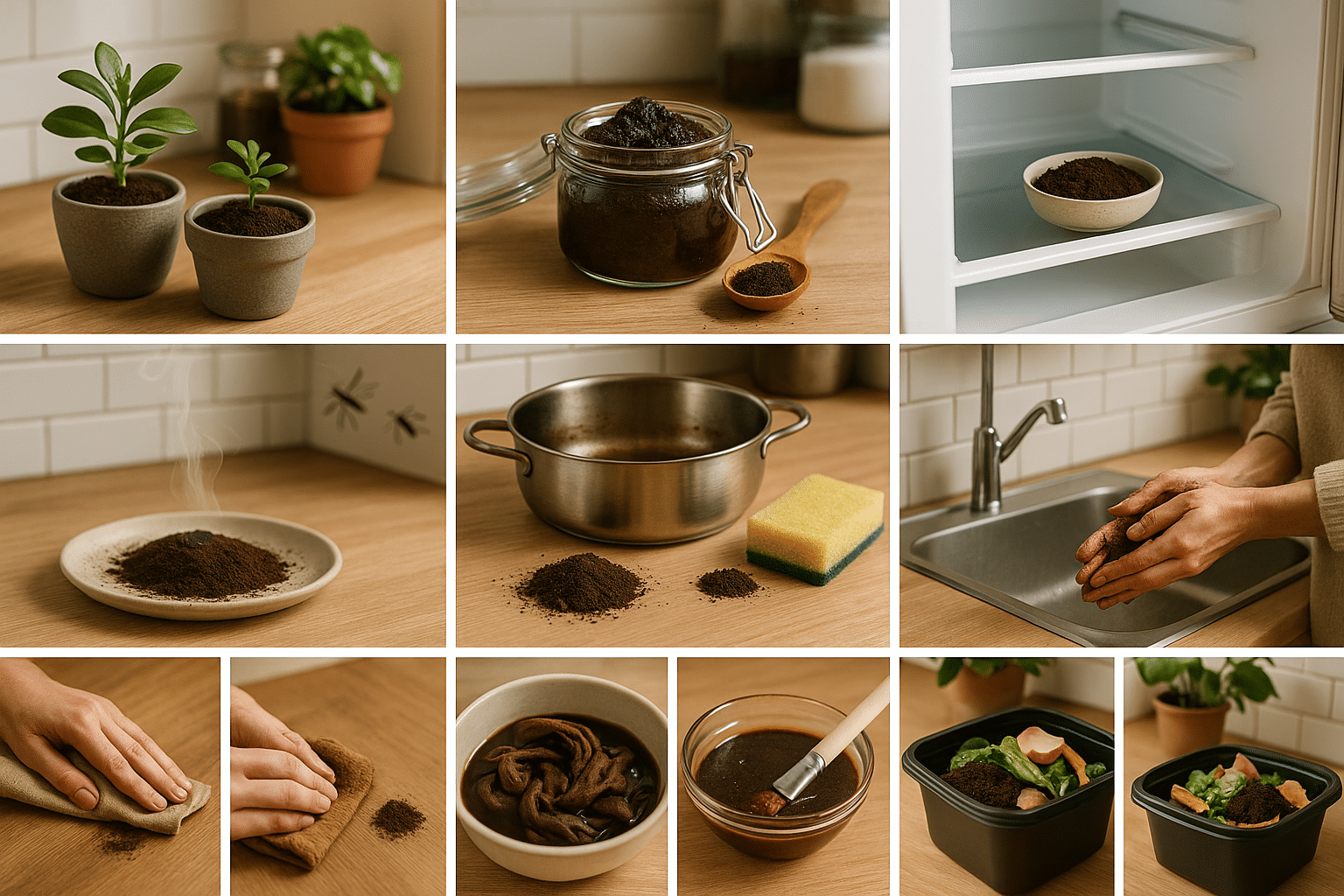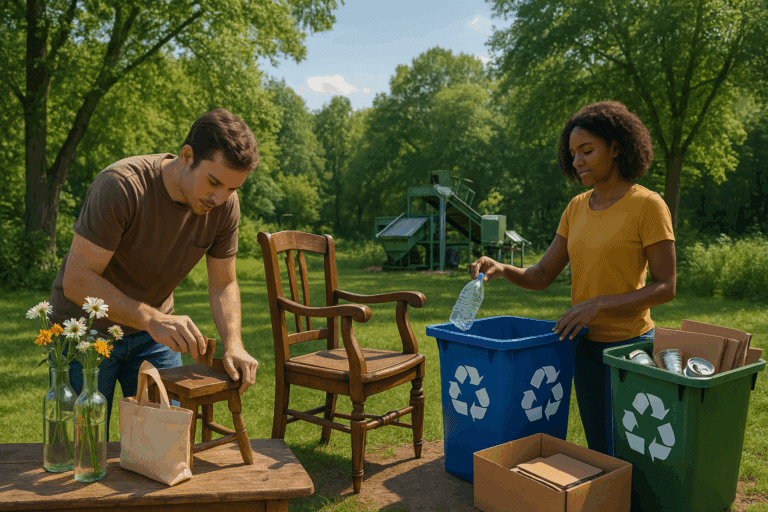An unexpected hero in this quest is something many of us discard without a second thought each morning: coffee grounds. In today’s article, ‘Bean There, Done That: 10 Ingenious Ways to Upcycle Your Coffee Grounds for a Sustainable Lifestyle’, we will delve into the underappreciated world of used coffee grounds, unearthing their potential to contribute to a greener lifestyle. 🌿☕
Undeniably, the simple act of brewing a cup of coffee leaves behind a seemingly useless byproduct. However, with an open mind and a dash of creativity, these once-discarded remnants can be transformed into an array of functional, environmentally friendly items. Ready to dive in? Let’s turn that cup of joe into an eco-hero!
We’ll be exploring how used coffee grounds can be a rich addition to your garden, providing essential nutrients to your plants and deterring pests. We’ll also delve into their potential as a natural cleaning abrasive, with surprising efficiency and a pleasant aroma as added bonuses. ☕✨
Moreover, we’ll discuss how these grounds can play a role in self-care routines, serving as the base for homemade skincare products or as a natural deodorizer. Curious about how your morning coffee can contribute to a more sustainable skincare regime? Stay tuned! 🧖♀️💆♂️
And that’s not all. The culinary world also sees potential in used coffee grounds. We’ll introduce you to unique and delicious ways these leftovers can add a depth of flavor to your cooking and baking, making your kitchen both greener and more gourmet. Bon appétit! 🍽️
Throughout this article, we will not only provide practical, step-by-step guides to implementing these upcycling methods, but we’ll also delve into the science behind why they work. Why do coffee grounds deter pests? How do they aid in skin exfoliation? These questions and more will be answered, bridging the gap between technical knowledge and everyday application.
As we move forward, it is important to keep in mind that the quest for sustainability is not about perfection. Each small step we take towards minimizing waste, such as upcycling coffee grounds, brings us one step closer to a more sustainable lifestyle. And in this process, we hope to help you uncover the hidden potential in everyday items, fostering creativity and environmental consciousness.
So, whether you are a coffee connoisseur, a passionate environmentalist, or someone simply looking to add a dash of sustainability to your daily routine, this article promises to be an engaging and enlightening read. From garden care and home cleaning to skincare and culinary exploration, let’s discover how we can turn our morning coffee ritual into a daily act of environmental stewardship. ☕🌿🌎
Join us as we embark on this journey of exploration and innovation, using our morning brew to brew up some eco-friendly solutions. ‘Bean There, Done That: 10 Ingenious Ways to Upcycle Your Coffee Grounds for a Sustainable Lifestyle’ is about to redefine your relationship with coffee and sustainability. Ready to rethink your coffee grounds? Let’s get brewing!
☕ Repurpose, Reuse, Recycle: Transform Your Coffee Grounds
Every morning, millions of people across the globe start their day with a hot cup of coffee. But what happens to the coffee grounds once the caffeine kick has been enjoyed? More often than not, they are simply thrown away. However, these used coffee grounds can actually be transformed into useful, sustainable materials. This article will explore ten ingenious ways to upcycle your coffee grounds for a more sustainable lifestyle.
Before we dive into the details, let’s take a moment to appreciate the value of upcycling. It’s all about taking materials that would otherwise be wasted and transforming them into something useful. It’s a powerful strategy for reducing waste, conserving resources, and promoting sustainability. And when it comes to coffee grounds, the possibilities for upcycling are surprisingly diverse.
So, get ready to discover how you can turn your daily coffee habit into an eco-friendly practice. From gardening and cleaning to beauty treatments and even biofuel, let’s explore the fascinating world of coffee ground upcycling. For a visual guide on how to repurpose coffee grounds, I recommend checking out the video “10 Amazing Uses for Used Coffee Grounds” by Household Hacker on YouTube.
🌱 Coffee Grounds in Your Garden
Coffee grounds are rich in nutrients, and plants love them. They provide a great natural fertilizer, can help to improve soil structure and even repel pests. Not to mention, using coffee grounds in your garden is an excellent way to reduce waste and promote sustainability.
The nitrogen content in coffee grounds makes them particularly useful for plants that need a lot of it, like tomatoes, spinach, or corn. However, keep in mind that coffee grounds should be used as a supplement to a balanced fertilizer program, rather than the only source of nutrients for your plants.
One of the most surprising uses of coffee grounds in the garden is as a natural pest deterrent. Slugs, snails, and even cats dislike the smell of coffee, so sprinkling grounds around your plants can help keep these pests at bay.
How to Use Coffee Grounds in Your Garden:
- Spread a thin layer of coffee grounds around your plants or mix them into the soil.
- Add coffee grounds to your compost pile to enrich it with nitrogen.
- Make a coffee ground “tea” by soaking used grounds in water overnight, then use this mixture to water your plants.
✨ Beauty Treatments with Coffee Grounds
Coffee grounds can also be upcycled into natural beauty treatments. Their abrasive texture makes them ideal for exfoliating the skin, while the caffeine content can help to reduce the appearance of cellulite and puffiness.
When mixed with a bit of oil, such as coconut or olive, coffee grounds can be transformed into a simple, yet effective, body scrub. Not only does this homemade scrub leave your skin feeling soft and smooth, but it also helps to increase circulation and promote healthier skin.
For a more targeted treatment, coffee grounds can also be used to create a DIY under-eye mask. The caffeine in coffee helps to constrict blood vessels, reducing puffiness and dark circles under the eyes.
DIY Coffee Grounds Beauty Treatments:
- Body Scrub: Mix 1 cup of coffee grounds with 1/2 cup of coconut oil and a few drops of your favorite essential oil.
- Under-Eye Mask: Mix 1 tablespoon of coffee grounds with 1 tablespoon of coconut oil, then apply to the under-eye area and leave on for 10-15 minutes before rinsing.
🔥 Creating Biofuel with Coffee Grounds
Did you know that coffee grounds can also be converted into a source of renewable energy? Scientists have found that coffee grounds can be processed to produce biofuel, a type of fuel derived from living matter.
Used coffee grounds contain about 15% oil by weight. This oil can be extracted and processed to create biodiesel. While the process may be too complex for home-brewed fuel production, it’s an exciting development in the field of renewable energy and showcases the untapped potential of coffee waste.
Researchers estimate that the coffee grounds produced by the world’s coffee drinkers could produce around 2.9 million tons of biodiesel annually. This type of innovation demonstrates how everyday waste materials, like coffee grounds, can be transformed into valuable resources, contributing to a more sustainable future.
The Science Behind Coffee Grounds Biofuel:
- Coffee grounds are dried and processed to extract oil.
- The oil undergoes a chemical reaction called transesterification to convert it into biodiesel.
- The remaining coffee grounds can be used to produce a type of solid fuel known as biochar.
🧹 Cleaning and Deodorizing with Coffee Grounds
Coffee grounds are not only useful in the garden and beauty treatments but also in cleaning and deodorizing. Their abrasive texture and strong odor-absorbing properties make them a valuable addition to your cleaning routine.
For instance, coffee grounds can be used to scrub pots and pans, clean fireplaces, or even remove stubborn smells from your fridge or hands. Plus, by using coffee grounds for these tasks, you are not only reducing waste but also reducing the need for harsh chemical cleaners.
So next time you finish your morning brew, think twice before throwing those grounds away. They might just be the secret ingredient you need for a cleaner, greener, and more sustainable lifestyle.
Cleaning Uses for Coffee Grounds:
- Scrub: Use coffee grounds to scrub pots, pans, and surfaces. The abrasive texture helps to remove grime, but be cautious of using on delicate surfaces as it may scratch.
- Deodorizer: Place coffee grounds in a bowl in your fridge or freezer to neutralize odors. Similarly, you can rub coffee grounds on your hands to remove lingering smells from foods like garlic or onions.
- Fireplace Cleaner: Sprinkle damp coffee grounds over the ashes in your fireplace before cleaning. The grounds help to weigh down the ash and prevent it from clouding up into your living space.
Upcycling Coffee Grounds: A Step Towards Sustainability
From garden enrichment and beauty treatments to biofuel and cleaning, the humble coffee ground proves that one man’s trash is indeed another man’s treasure. By finding creative and practical ways to upcycle our coffee grounds, we can take steps towards a more sustainable lifestyle, reducing waste, and conserving resources.
With this guide, I hope you’ve been inspired to give coffee ground upcycling a try. Remember, every small step counts when it comes to sustainability. So, the next time you brew a cup of joe, think about the potential of those coffee grounds, and turn your daily caffeine fix into an eco-friendly habit.
If you’d like to learn more about sustainable practices, I recommend watching the video “10 Ways to Reduce Waste | Zero Waste for Beginners” by Sustainably Vegan on YouTube.

Conclusion
In conclusion, we can affirm that the fields of IT and Engineering are indeed complex, yet captivating domains that require technical expertise and a keen understanding. Throughout this comprehensive article, we have explored intricate aspects of these sectors, shedding light on several critical elements that shape their operational structure and efficiency.
We first delved into the fundamentals, elucidating how the principles of software engineering and information technology serve as the backbone for most modern technological advancements. We expanded on the role of software development and its various stages, emphasizing the significance of each phase. From planning, designing, coding, testing, to maintenance – every step plays a pivotal part in the life cycle of software development, ensuring the production of high-quality and efficient software solutions.
Our exploration continued as we delved into various IT infrastructures, the importance of cybersecurity, and the essential role of data management. The significance of data analysis and information management in the current digital age was highlighted, elaborating on how they provide competitive advantages to businesses and industries across the globe.
The topic of Artificial Intelligence (AI) and its implications in the modern world was also discussed. We explored how AI has revolutionized various sectors, offering automation, enhancing accuracy, and promoting efficiency.
However, understanding these intricate subjects is no small feat. Therefore, continued learning and skill enhancement are crucial. Platforms like [Lynda](https://www.lynda.com/), [Coursera](https://www.coursera.org/), and [Udemy](https://www.udemy.com/) offer numerous courses on these topics, helping you to stay updated with the latest trends and developments.
By sharing this knowledge, our aim was to inform, enlighten, and encourage further exploration into these fascinating fields. We trust that this article has provided you with valuable insights and fostered an improved understanding of the multifaceted domains of IT and software engineering.
But the journey of learning does not end here. The ever-evolving nature of these fields necessitates continuous education and staying abreast of the latest advancements. So, do not shy away from diving deeper into these subjects, reading more, questioning more, and learning more.
Please feel free to share this article with others who might find it helpful 📚💡. Also, don’t hesitate to leave your valuable comments below. Your feedback and queries are most welcome as they help us improve and deliver better content to you 👥💬.
Finally, we hope this article has been an enjoyable and informative read, inspiring you to continue your journey in the captivating world of technology. Remember, “The only source of knowledge is experience.” – Albert Einstein.
Sources: [Microsoft Documentation](https://docs.microsoft.com/en-us/), [IBM Developer](https://developer.ibm.com/), [Google Scholar](https://scholar.google.com/)
End of Article 🏁💻💾.



